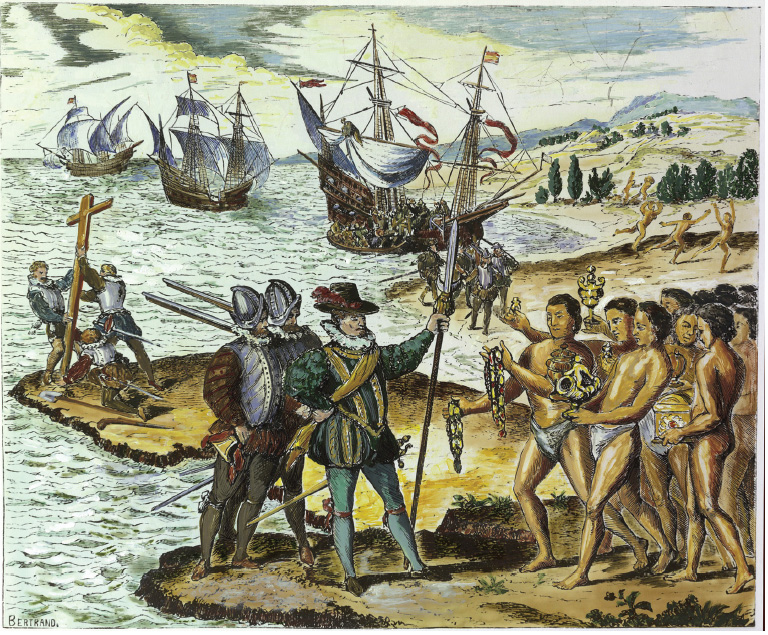The first meeting of Columbus and his Spanish explorers with the natives of the Caribbean was one to be remembered. Posterity has pictured this scene as one of happy explorers sharing food with the natives; but the truth of that first encounter, and its aftermath for the natives, was far from happy. Through the exchange, the natives received a number of diseases for which they had no immunities; and one of the largest demographic disasters the world has ever seen was the result. But the disease syphilis was also exchanged, between the New World and the Old World. The nature of this exchange of syphilis, though, is full of debate and speculation concerning its origins.

Syphilis was one of the most notable examples of New World diseases that traveled to the Old World in what historians now call the Columbian Exchange. There are two different theories for how syphilis was spread. The Columbian hypothesis claims that syphilis was spread by Columbus and his crew on their voyage back to the Old World. Once they contracted it from natives in the Americas, the crew then went back to the Old World. The evidence that supports this hypothesis is the assumption that Columbus’s crew members, once returned back to Spain, joined Spain’s war effort in Naples, exposing the disease to local prostitutes. Once exposed to syphilis, the disease was spread quite easily from the prostitutes to other soldiers and locals, thus increasing the spread of syphilis in the Old World. This explanation for the spread of syphilis is possible because some of Columbus’s crew did in fact join the war effort against Naples and most likely they did mingle with the locals there causing the spread of syphilis.1
The other theory, the Pre-Columbian hypothesis, was that syphilis had always been an Old World disease, but its spread was only exacerbated through the interaction of the natives and Europeans during the Columbian Exchange. This second theory is plausible since there is evidence of pre-Columbian Old World skeletons that show scars similar to syphilis scars. What this means is, since the skeletons from the Old World have scars and written accounts of symptoms similar to syphilis that pre-date the first exchange between Columbus and the Americas, syphilis could have possibly been an Old World disease. Now this theory of syphilis’ origin is a matter of syphilis being yet another disease that was spread from the explorers. Both of these hypotheses are plausible.2
Although these two theories for the origin of syphilis have been debated for decades, a less know third theory has emerged. This third theory suggests that syphilis was both an Old World and a New World disease. Syphilis is thought to “evolved simultaneously with human.”3 In other words, when the respectively different populations of humans evolved, the disease known as syphilis grew with the population in both hemispheres. This theory, though, is mostly unknown because of the two older and more established theories, which have dominated the discussions on syphilis’ origins. This third theory puts an interesting twist on this long debate.4
Through the exchange of syphilis, the lives of natives and explorers were changed in a drastic way. The picture of happy natives and explorers sharing food is one everyone has seen but the different narrative of the debate of syphilis’ origins is one many have not seen. The three theories of syphilis are all very real and possible, which is why the debate of syphilis is such a topic that can cause arguments. The debate over syphilis’ origins is one that will most likely be researched and hypothesized over for many years to come.
- Nathan Nunn and Nancy Qian, “The Columbian Exchange: A History of Disease, Food, and Ideas,” The Journal of Economic Perspectives 24, no. 2 (2010): 166-167. ↵
- Nathan Nunn and Nancy Qian, “The Columbian Exchange: A History of Disease, Food, and Ideas,” The Journal of Economic Perspectives 24, no. 2 (2010): 167. ↵
- Brenda J. Baker et al., “The Origin and Antiquity of Syphilis: Paleopathological Diagnosis and Interpretation and Comments and Reply,” Current Anthropology 29, no. 5 (1988): 703–706. ↵
- Brenda J. Baker et al., “The Origin and Antiquity of Syphilis: Paleopathological Diagnosis and Interpretation and Comments and Reply,” Current Anthropology 29, no. 5 (1988): 704. ↵



53 comments
Vanessa Preciado
Hi Esperanza, Im very fascinated by this article, as I did not realize how far syphilis went back. As far as the Europeans possibly bringing that disease to the Natives, I don’t find that hard to believe , Iv’e been reading this book American History by Alan Brinkley, Iv’e noticed that the Europeans really were to blame for bringing the natives many different diseases and even taking out a lot of their population. Nice job on your article!
Daniel Gimena
The story and consequences of the spread of diseases that came with the conquer of the New World is known by everyone. Instead, I was not aware of the diseases that spread in the Old World because of the contacts that Europeans had with native Americans. One of this diseases is Syphilis and, as the author states, there is a lot of debate about how this disease arrived to Europe. Any of the 3 theories presented can be the true one, but I think that each of them has some truth in it, and what is clear is that the disease already existed in the New World. In any case, the spread of diseases without control has always supposed a threat to human health around the globe, because of the fear of a global Pandemic. Prove of this is our actual situation, which will be remembered as the first Pandemic that has reached all the parts of the World.
Yaniev Ibarra
I always knew that Europeans had brought along with them diseases into the New World, yet I found it fascinating to know more specifically on syphilis. Crazy to think that the disease origins still has many unknown factors. This article definitely brought explications but how it affected the Natives is interesting to know about. Reminds me of Covid-19 and how there are still many unknown things about the disease and lots of research being done to help stop the spread and eventually prevent the death of thousands of more people.
Samson Pullattu
I had always assumed that the first theory was fact, but these other two theories make sense. The scars on pre-Columbian Old-World skeletons that appeared similar to syphilis scars would even seem to disprove the first theory. The third theory is quite an interesting one, suggesting that syphilis was a disease carried by both Worlds as time had passed and the Columbian Exchange only exacerbated its spread. This suggests that syphilis has existed when humans made their way to the Americas thousands of years ago via the Bering Strait. This would make syphilis one of the oldest diseases to date, and I think humanity would have noticed it by the time of the Columbian exchange if the third theory is correct.
Yadira Chavez
This article is great at explaining the many theories on the beginning and spread of Syphilis. It is mind-boggling that we know so little about our ancestors and their past, and that we have to look as closely as the marks on their long passed bodies to find answers. The fact of the matter is that there are probably a lot of things that history books have taught us that either never happened or happened very differently. The spreading of syphilis, if spread like theories suggests, must have been really scary to witness and go through, so this article does great at shedding some light on that.
Josephine Tran
The origins as well as the stigmas of the disease had never really been of focus when thinking about the disease syphilis. The factors and reasoning from the article make a lot of sense, but I wonder if there were also factors of environment that played a role in the disease and its outbreak. I hadn’t known that three different origin stories existed for this one disease. It is expected though seeing how far syphilis dates back in our history. I enjoyed the integration of history and medicine in this article.
Lilia Seijas
I found this article to be really interesting. The origins of syphilis have always been said to have started in the Americas. However, the idea that they could have started in the Old World is never really analyzed. This article presents the idea that maybe, just maybe, all the diseases transmitted, including syphilis, were brought to the Americas by the Spanish.
This article was well written, however, it could have explained the number of deaths the disease caused more in-depth.
Jesus Parker
Crazy to read on how we exactly do not know the origins of a deadly disease that was somewhat recent in relation to the human race. Also, it is a recurring trend on how the diseases would travel fast around everywhere. If people would have only known to take simple measures to stop the spread of this disease, who knows how many lives could have been saved.
Roberto Rodriguez
I really thought that it was going to be a simple story, but I have to admit that I did enjoy this article a lot more than I originally thought. It is articles like these that make me want to study immunology, it is kind of like an interesting and mysterious puzzle that we are still trying to figure out. I find it interesting that there are three different theories as to the origins, it is even more compelling when you take into account that all of them seem plausible. I guess it is just a mystery that we have yet to find out.
Abigale Carney
Well written article! Syphilis is something I have read and learned about, but I have never fully understood the origins of this disease or why it had occurred. After reading this article, I feel better to know that there are many theories to the origins of this disease but that also worries me. I agree with a previous comment written by Hali Garcia when they state that the disease could have been brought over by Europeans and then reacted differently within the New World environment. Very interesting article!